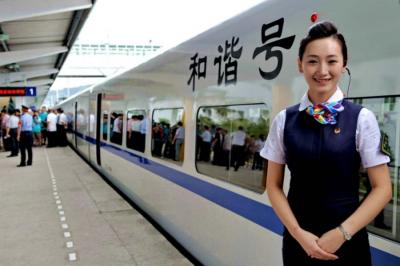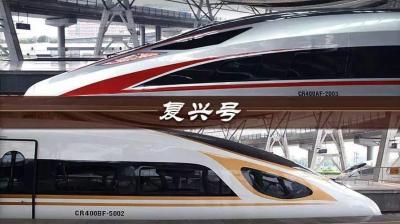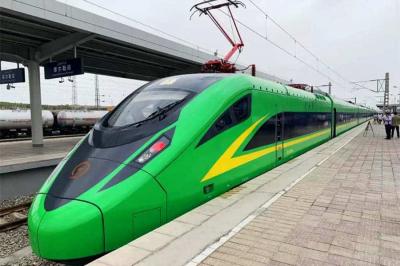China High-speed Railway (HSR)
“China has built the largest high-speed rail network in the world. The impacts go well beyond the railway sector and include changed patterns of urban development, increases in tourism, and promotion of regional economic growth. Large numbers of people are now able to travel more easily and reliably than ever before, and the network has laid the groundwork for future reductions in greenhouse gas emissions,” said Martin Raiser, World Bank Country Director for China.

According to the document "Development of China's High-speed Railways" issued by the World Bank in July, 2019, China's high-speed rail operating mileage exceeds the total operating mileage of other countries put together, with the lowest fares, and the construction cost is only about two-thirds of the construction costs of other countries.
Different from most of the western countries, the rail service in China is all run by a state-owned company called China Railway (China State Railway Group Co., Ltd), which is responsible for the operation of passenger and freight transportation by rail in the vast country. Since 2007, China has entered the era of HSR (high speed rail). In the past years, we witnessed the dramatic changes. By the end of 2020, the total operating mileage of China's high-speed railways reached 37,900 kilometers, ranking No. 1 in the world, in contrast to the total mileage of all railways in China – 146,300 kilometers (the second longest in the world).
China high-speed rail service (also called CRH) plays a more and more important role in current Chinese people’s life. According to the government documents (Code for Design of High-speed Railways TB10621-2014), China's high-speed railways are passenger-dedicated railways with a design speed of 250 kilometers per hour or faster and the speed of more than 200 kilometers per hour at its initial operating period. According to the "Medium and Long-term Railway Network Planning (2016)", China's high-speed railway network is composed of all new lines with a design speed of more than 250 kilometers per hour and some existing railways with a design speed of more than 200 kilometers per hour after technology transformation.
Classification of High-speed Railways
China's high-speed railways are diverse in forms and types.According to the different status and service range in the network, China's high-speed railways can be divided into trunk and branch lines. (ie, eight vertical & horizontal major trunk lines, regional connecting lines) and branch lines (extension lines, intercity lines, etc.)
Based on the design speed, China's high-speed rail can be divided into three levels: 250 kilometers per hour, 300 kilometers per hour, and 350 kilometers per hour.
According to other distinctive features, it also consists of intercity high-speed rail, mountain high-speed rail, joint-venture high-speed rail, and transnational high-speed rail.
Classification of High-speed Trains
Generally There are three major types of high-speed train service in China, namely, G (pronounced as Gao), D (pronounced as Dong) and C (pronounced as Cheng) passenger train service. G train service generally features EMU trains running on passenger-dedicated high-speed rail lines and operating at top speeds of 250 - 350km/h.
D train service features EMU trains running at lower speeds, whether on high-speed or non-high-speed track. D-class trains can vary widely in actual trip speed, usually between 160-250km/h.
C train service features the relatively shorter intercity train ride. The top speed is 350 km/h (e.g. Beijing-Tianjin), but most operate from 200 to 160 km/h.
Hexie and Fuxing EMU Trains
In April 2007, the first EMU train called "Hexie" departed from Shanghai Station to Suzhou. In June 2017, the “Fuxing” EMU made its debut on the Beijing-Shanghai high-speed rail at the speed of 350 km per hour. At present, China's high-speed trains consist of two types: Hexie (和谐号, Harmony) and Fuxing (复兴号, Rejuvenation). In 2017, CRH service more than 4,000 trains per day, with a daily ridership of about 4.6 million.

In 2012, under the leadership of China Railway, the R&D project of China-standard EMU trains was launched. As the version 2.0, the advanced EMU trains with completely independent intellectual property rights rolled off the production line, and were named as “Fuxing” on June 25, 2017, which made its debut in both directions on the Beijing-Shanghai high-speed rail on the 26th.
>> Recommended 14 Days China History Tour on Bullet Train
The difference between Harmony and Rejuvenation EMU trains
| Harmony (Hexie) | Rejuvenation (Fuxing) | |
|---|---|---|
| Design and appearance | There is a "bulge" on the roof of the "Harmony" EMUs, which is actually the pantograph and air conditioning system. | "Fuxing" sinks this "bulge" into the air duct system under the roof, making the train not only look intact, but the air resistance is reduced by 7.5%-12.3% compared to the CRH380 series. |
| Models and Speed | As mentioned above, Harmony EMUs have many models with different speeds. Generally, it runs at a speed of more than 160 kilometers per hour and can reach a maximum of 380 kilometers (CRH380). | Currently there are 5 major models of Fuxing EMUs: CR200J, CR300AF, CR300BF, CR400AF and CR400BF. The test speed of Fuxing can reach 400 kilometers per hour, and the standard operation speed is 350 kilometers per hour. The slower models include CR200 (160km per hour) and CR300 (250km per hour). |
| Safety | Maximum 2000 monitoring points are applied. | "Fuxing" is equipped with an intelligent sensing system and a powerful safety monitoring system. More than 2500 monitoring points are deployed. |
| Space | 3700mm in height The second-class seat pitch is 0.99 meters, and the first-class seat pitch is 1.06 meters. | 4050mm in height, more space The second-class seat pitch has been increased to 1.02 meters, the first-class seat pitch has been increased to 1.16 meters, and the second-class seat has been lengthened by 2 cm. |
| Design life | No available. | Full car coverage, free for the whole journey, each car can carry 80-120 mobile terminals, and it can be connected automatically without a password. |
| Socket power | The charging socket has only 2 power supplies per row of seats. | There is 1 socket for every two seats, and 2 sockets for every 3 seats. |
| Energy consumption | If CRH380 at the speed of 350 km per hour, energy consumption is higher. | 10% lower. When the train runs at a speed of 350 km per hour, the per capita energy consumption per 100 kilometers decreased by about 17%. |
>> Recommended 9 Days Beijing Xian Shanghai Tour by Speed Train
High Speed Rail Station
There are 2 types of high-speed railway stations in China: new ones designed and worked solely for high speed trains, original ones with upgrading and renovation to suit both high-speed and conventional trains. Anyhow, China Railway does not make any specifications for high-speed railway stations. All the official station names do not have the words "high-speed rail", like Beijing South Station, Xian North Sation, etc.
Besides, there have been also 54 inspection stations for the high speed trains (also called EMUs – Electric Multiple Unit) in different parts of China until 2018, which is nicknamed as “Hospital of EMUs”. They are in charge of the inspection, maintenance and repair of high-speed trains.
Speed Record
How fast is the high speed train in china?
On December 3, 2010, the "Harmony" CRH380A EMU set a test speed record of 486.1 km/h on the Beijing-Shanghai high-speed railway. On January 16, 2014, the test speed of China's CIT500 high-speed train in the laboratory reached 605 km/h. As of 2019, the Fuxing EMUs have achieved automatic driving at a speed of 350 kilometers per hour for the first time in the world.

As of the end of 2015, the total operating mileage of China's high-speed railways has reached 19,000 kilometers. As of the end of 2016, the total operating mileage of China's high-speed railways has exceeded 20,000 kilometers. As of the end of 2017, the total operating mileage of China's high-speed railways has reached 25,000 kilometers. As of the end of 2018, the total operating mileage of China's high-speed railways exceeded 29,000 kilometers. As of the end of 2019, the total operating mileage of China's high-speed railways reached 35,000 kilometers. Until the end of 2020, the total operating mileage of China's high-speed railways has reached 37,900 kilometers.
Passenger Traffic
From August 1, 2008 to July 11, 2016, China's high-speed trains sent more than 5 billion passengers. During the Spring Festival Transport in 2017, China's high-speed railway sent a total of 180 million passengers, accounting for 51.4% of the country's total railway passenger transport. In 2018, China's high-speed trains transported a total of 2.005 billion passengers.
The Fares of CRH
China High-speed rail is relatively more affordable as fares have remained stable while worker wages have grown sharply over the same period, which made it the most popular way of long distance travel among the average Chinese people.
The prices/km for China’s high-speed trains: (Exchange rate: U$1=CNY6.5)
| High-speed Train | First Class | Second Class |
|---|---|---|
| G trains (Speed: 300km/h) | 0.74 Yuan (U$0.113) | 0.46 Yuan (U$0.07) |
| D trains (Speed: 200km/h) | 0.37 Yuan (U$0.057) | 0.30 Yuan (U$0.046) |
Currently, China's high-speed rail service costs significantly less than similar systems in other developed countries, but is considerably more expensive than conventional rail service. After all, the CRH has unparalleled advantages compared to the latter in speed, comfortability, punctuality and cleanness.
Impact on other modes of transportation
The expansion of high-speed railroad in China has great impacts on other modes of transportation.
Air
The widespread of CRH network has forced domestic airlines in China to slash airfare. Many regional flights have been canceled. The intercity trips under 500 km (310 mi) are greatly affected as high speed rail service has more advantages on low cost, punctuality, time-consumption and more departures. Flights on routes over 1,500 km (930 mi) are generally unaffected. In 2018, high-speed rail transported as many as 2 billion passengers (3.37 b in total by rail), while 0.612 billion by the country's airlines.
Long distance bus
The market for inter-city long distance buses shrank considerably due to the connection of the China high-speed rail among the big and small cities and towns. Only those bus lines to the destinations without the reach of high speed rail are not affected. In some areas, to compete with CRH, the bus companies adopted measure to upgrade the bus facilities and services to attract the passengers, which still plays its fundamental part in the capillary-like routes among smaller towns. Generally speaking, bus transport service has become a supplementary mode for mass transportation in the country.
>> Recommended 16 Days China Speed Train Discovery
Concerns
According to the World Bank, a stable long term planning and standardization of technology and design used in the China high-speed rail helps to reduce financial and operational cost. Standardization of designs and procedures such as train tracks, rolling stocks, and signal systems keeps the construction cost down. Moreover, State-owned China Railway (corportation) also uses bulk purchasing to reduce material prices. But the mounting local government debts began to draw the attention of the central government, which made the latter halt several high-speed rail projects recently in 2 provinces.